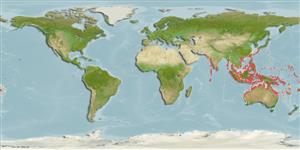Common names from other countries
>
Eupercaria/misc (Various families in series Eupercaria) >
Nemipteridae (Threadfin breams, Whiptail breams)
Etymology: Scolopsis: Name from the Greek masculine noun 'skolos' meaning 'thorn' and suffix '-opsis' (from Greek feminine n. 'opsis' meaning 'aspect', 'appearance') meaning ‘thorny appearance’ presumably referring to 'les dentelures de la préopercule, en ont aussi, et même d'épineuses, aux sous-orbitaires' mentioned by Cuvier (1814) in his designation of the genus. Name ending in -'opsis' are treated as feminine according to ICZN 1999: Article 30.1.2 (Ref. 130620).
More on author: Bloch.
Environment: milieu / climate zone / depth range / distribution range
Ecología
marino asociado a arrecife; rango de profundidad 1 - 25 m (Ref. 9710). Tropical; 32°N - 36°S, 66°E - 172°W (Ref. 3810)
Indo-West Pacific: Maldives (Ref. 11303) and the Laccadive Islands to Fiji, north to southern Japan, south to Lord Howe Island. Recently reported from Tonga (Ref. 37816).
Tamaño / Peso / Age
Maturity: Lm ? range ? - ? cm
Max length : 25.0 cm TL macho / no sexado; (Ref. 90102); common length : 13.0 cm SL macho / no sexado; (Ref. 3810)
Espinas dorsales (total) : 10; Radios blandos dorsales (total) : 9; Espinas anales: 3; Radios blandos anales: 7. This species is distinguished by the following characters: head scales reaching to or just in front of anterior nostrils; lateral line scales 43-47 (usually 45-46); pectoral fin rays 16-18 (usually 17); snout length less than eye diameter; greatest body depth 2.5-3.0 in SL. Colour dark grey on head and back with diagonal black-edged white band separating dark area from the rest of the mainly whitish body; white blotch below posterior dorsal fin; 3 yellow stripes on upper head; juveniles with alternating black and yellow stripes on the upper half and whitish below, Batesian mimic of the poison-fanged blenny Meiacanthus grammistes (Ref. 90102).
Common on coral reefs. Adults occur on most reef habitats, usually in pairs, and juveniles inshore or in lagoons or rubble zones (Ref. 48635). Occurs singly or in small aggregations. Feeds on small fishes and benthic invertebrates. A protogynous hermaphrodite (Ref. 9785). Juvenile mimics poison-fanged blenny Miacanthus grammistes, Batesian mimic (Ref. 90102). Caught mainly by handline and live specimens captured by hand net for the aquarium export trade; no major fishery exists (Ref. 9785). It is parasitised by the monogenean Anoplodiscus hutsonae on the pectoral fins and body surface (Ref. 124057).
Life cycle and mating behavior
Maturities | Reproducción | Spawnings | Egg(s) | Fecundities | Larva
Russell, B.C., 1990. FAO Species Catalogue. Vol. 12. Nemipterid fishes of the world. (Threadfin breams, whiptail breams, monocle breams, dwarf monocle breams, and coral breams). Family Nemipteridae. An annotated and illustrated catalogue of nemipterid species known to date. FAO Fish. Synop. 125(12):149p. Rome: FAO. (Ref. 3810)
IUCN Red List Status (Ref. 130435)
CITES (Ref. 128078)
Not Evaluated
Threat to humans
Harmless
Human uses
Pesquerías: pesquerías de subsistencia; Acuario: Comercial
Herramientas
Special reports
Download XML
Fuentes de Internet
Estimates based on models
Preferred temperature (Ref.
115969): 25.1 - 29.3, mean 28.6 (based on 2688 cells).
Phylogenetic diversity index (Ref.
82804): PD
50 = 0.5000 [Uniqueness, from 0.5 = low to 2.0 = high].
Bayesian length-weight: a=0.01380 (0.00863 - 0.02207), b=3.06 (2.93 - 3.19), in cm Total Length, based on LWR estimates for this species & Genus-body shape (Ref.
93245).
Nivel trófico (Ref.
69278): 3.6 ±0.50 se; based on food items.
Resiliencia (Ref.
120179): Alto, población duplicada en un tiempo mínimo inferior a 15 meses (Preliminary K or Fecundity.).
Fishing Vulnerability (Ref.
59153): Low vulnerability (15 of 100).
